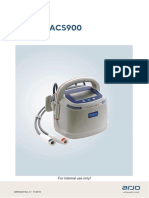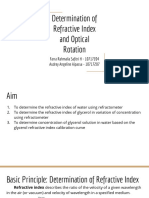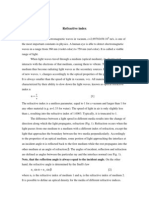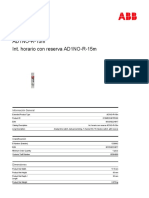Technical Basics Refractometry
Uploaded by
Jacqueline CastelanTechnical Basics Refractometry
Uploaded by
Jacqueline CastelanTechnical basics refractometry
The speed of light and the refractive index The principles of boundary behaviour let us expect that we or in a different way: Example: At a temperature of 20°C, cyclohexane has
In a vacuum, light travels at 300.000 km/s while travel- would observe both reflection and refraction. We would also the same refractive index as a sucrose solution of
ling through water, the speed is about 225.000 km/s, observe that the intensity of the reflected and refracted αcrit = arcsin (n2 / n1) 52.9 Brix.
which is 25% less. In a sapphire it will only reach rays do not remain constant. At angle of incidence close But at a temperature of 25°C, the same cyclohexane has
170.000 km/s. to 0 degrees, most of the light energy is transmitted across The above formula means: if one knows exactly the refractive the refractive index of a sucrose solution of 52.1 Brix.
A refractometer is a measuring instrument for the the boundary and very little of it is reflected. As the angle index of the more dense medium n1, which could for example That means that a special scale, which shows the value
speed of light. The result will not be indicated directly is increased to greater and greater angles, we would begin be a glass prism or made of artificial sapphire, then by measu- for cyclohexane in a temperature corrected way, may
but related to the speed of light in air. This comparison to observe less refraction and more reflection. That is, as ring the critical angle of total reflection, one could find out not be used for measuring sucrose solutions at the
is called refractive index. The indication, that a certain the angle of incidence is increased, the brightness of the the refractive index of the second medium n2. same time.
material has a refractive index of 1.5 thus means, that refracted ray decreases and the brightness of the reflected
the speed of light travels 50% faster through air than ray increases. Finally, we would observe that the angles of Every temperature correction is substance specific.
through this material. the reflection and refraction are note equal. Since the light Total reflected light
waves would refract away from the normal, the angle of 40 Brix solution, 0.00015 per °C
Who is interested in the speed of light in samples? refraction would be greater than the angle of incidence.
The refractive index is a value specific to a material. It In case the incident angle is 60° there will be no refracted Temperature 20.0°C 20.1°C 21.0°C
Prism with
depends on temperature and wavelength (λ = colour) ray any more, we would say: light is totally reflected. These sample Refractive index 1.39986 1.39985 1.39971
CCD-diode
of the light. Thus using a refractometer, will enable principles are depicted in the diagram below.
array
you to determine the concentration of a material,
0° 20° Light source Paraffine oil, 0.00036 per °C
if temperature and wavelength are known. But it is 42°
also possible, that different materials have the same Temperature 20.0°C 25.0°C 30.0°C
refractive index at various concentrations. Thus a clear 70° Since the light beam only probes a fraction of wavelength into Refractive index 1.48001 1.47825 1.47644
determination of liquid substances may only be suc- the second medium very dark and turbid samples can be
cessful with binary mixtures (Mixtures consisting of two measured without problems. By inserting a drop of liquid on
compounds). top of the measuring prism a very sharp line will appear dividing
In practice, the refractive index determines the mixing regions of below and above the critical angle. We conclude that it is possible to dertermine a tempe-
ratio also of multicompound solutions quite exactly and SCHMIDT+HAENSCH instruments determine the position rature correction for a substance and to program a
easily as in general only the concentration of one of of borderline by a high resolution CCD-diode array, thus refractometer in a way that it indicates only the concen-
the componends needs to be determined. Thus it is a 0° 15° 30° 45° 60° without moving parts. tration of this substance independent of the measuring
quantitative measurement. With known compounds, temperature.
also quality may be determined. For mixtures like for A more detailed picture below shows the case where light
example olive oil or orange juice, the measuring value impinges under such special angle that the refracted beam Temperature effects
within a certain range corresponds to a certain quality. makes an angle of 90° with the surface normal. A solution of 40 g of sucrose in 100 g of water has a refractive
index (RI) of 1.39986 at a temperature of 20°C. The same
Thus refractometry is a quality control of substances solution has a much lower RI value 1.39828 at 30°C.
Air n2 Refracted Air n2 The difference in the measured values is caused only by the
There is a definite correlation between the refractive 90° beam change of the temperature and not by change of the con-
index and the composition of many two-compound centration. The so called temperature correction therefore
solutions. The best known example for such a mixture is Totaly considers the influence of the temperature on the solution to
αG
a solution of sucrose in water, which has been studied reflected be measured. This is generally a non-linear behaviour (matrix)
throughly. A refractometer can be grated in a way that Water n1 Water n1 light in dependency of the different concentrations. Usually the
the value may be indicated directly as dry substance Critical angle Total reflexion product having been described the best is sucrose in purest
%RTS. For sucrose, this unit is also named Brix (abb. Bx). water solution: the so called Brix scale.
The determination of the density of samples can also A Brix scale therefore has to take into consideration the exact
be done with refractometry. As a rule in optical measu- There comes a time when all of the rays are reflected, this temperature, to be able to calculate the correct value.
ments density and dry substance corresponds to each happens when the angle of incidence is equal to or greater SCHMIDT+HAENSCH pays great attention to high stability of
other. than the critical angle αcrit, which is defined by the ratio of the temperature and temperature control during the measu-
the two indices of refraction: rement while developing and manufacturing our measuring
Refractometers convert the measured refractive indices devices. There are two different technical solutions offered:
in concentration or density. sin αcrit = nair / nwater - an active, external temperature adjustment by thermostat
as well as an
Where nair and nWater are the indices of refraction of the air - internal Peltier temperature regulation.
How can the refractive index be measured? and water, respectively. Generally this behaviour can be
written down in mathematical form as the snellius law, with Doing a pure sugar measurement, there is no need to apply
To understand total internal reflection, we begin with a the refractive indices n1 for water and n2 for air: a temperature regulation as the measured value for the Brix
thought experiment. Suppose that a laser beam inside scale is temperature corrected automatically.
of a water tank aims towards the air-water boundary. SCHMIDT+HAENSCH offers customer specific scales, linea-
Then suppose that the angle at which the beam direc-
n1 . sin α1 = n2 . sin α2 rised as far as concentration and temperature dependency
ted upwards is slowly altered, beginning with small are concerned. Most of our devices can be programmed for
Since the angle α1 can max. be 90°, thus causing α1 becoming
angles of incidence and proceeding towards larger and different products by the buyers themselves, too.
one, we can conclude:
larger angles of incidence.
n1 . sin αG = n2
SCHMIDT + HAENSCH SCHMIDT + HAENSCH
Optisch-elektronische Messinstrumente seit 1864 Tel.: +49 30 / 41 70 72-0 . www.schmidt-haensch.de Optisch-elektronische Messinstrumente seit 1864 Tel.: +49 30 / 41 70 72-0 . www.schmidt-haensch.de
You might also like
- Refractometry: Theory & Principle Instrumentation Applications Disadvantages100% (3)Refractometry: Theory & Principle Instrumentation Applications Disadvantages16 pages
- refractometry, nephelometry, polarimetry notesNo ratings yetrefractometry, nephelometry, polarimetry notes14 pages
- Refractive Index and Brix Standards PaperNo ratings yetRefractive Index and Brix Standards Paper11 pages
- Refractive Index As A Concentration Measurement PrincipleNo ratings yetRefractive Index As A Concentration Measurement Principle4 pages
- Manual de Uso Del Refractómetro de AbbeNo ratings yetManual de Uso Del Refractómetro de Abbe16 pages
- Determination of Refractive Index and Optical RotationNo ratings yetDetermination of Refractive Index and Optical Rotation16 pages
- Measuring Sugar Content of A Liquid With A Laser PointerNo ratings yetMeasuring Sugar Content of A Liquid With A Laser Pointer10 pages
- University of Basrah College of Engineering Chemical DepartmentNo ratings yetUniversity of Basrah College of Engineering Chemical Department5 pages
- Laboratory Report - Module 2 (Refractometry)No ratings yetLaboratory Report - Module 2 (Refractometry)37 pages
- 8.52 Refractometers: J. E. Brown B. G. LiptákNo ratings yet8.52 Refractometers: J. E. Brown B. G. Lipták8 pages
- Hollow Prism Physics Investigatory Project Class 12 Cbse (1)No ratings yetHollow Prism Physics Investigatory Project Class 12 Cbse (1)15 pages
- Refractive Index and Its Applications 2157 7544.1000e117No ratings yetRefractive Index and Its Applications 2157 7544.1000e1171 page
- Department of Chemistry: Rawalpindi Women UniversityNo ratings yetDepartment of Chemistry: Rawalpindi Women University5 pages
- Refractive Index and Its Applications 2157 7544.1000e117No ratings yetRefractive Index and Its Applications 2157 7544.1000e1171 page
- Refractive Index of Reference Material U c6cffd67No ratings yetRefractive Index of Reference Material U c6cffd674 pages
- PHA313 (22 - 23) - MOT - Optical Methods of The Analysis Presentataion - OMA - FINAL - 24 10 22 INo ratings yetPHA313 (22 - 23) - MOT - Optical Methods of The Analysis Presentataion - OMA - FINAL - 24 10 22 I71 pages
- Colour and the Optical Properties of Materials: An Exploration of the Relationship Between Light, the Optical Properties of Materials and ColourFrom EverandColour and the Optical Properties of Materials: An Exploration of the Relationship Between Light, the Optical Properties of Materials and ColourNo ratings yet
- Cavity Ring-Down Spectroscopy: Techniques and ApplicationsFrom EverandCavity Ring-Down Spectroscopy: Techniques and ApplicationsGiel BerdenNo ratings yet
- Immediate access to Electric and Hybrid Vehicles Design Fundamentals 1st Edition Iqbal Husain ebook full chapters100% (1)Immediate access to Electric and Hybrid Vehicles Design Fundamentals 1st Edition Iqbal Husain ebook full chapters77 pages
- (Ebook) Selman's the Fundamentals of Imaging Physics and Radiobiology by Victor White ISBN 9780398093181, 0398093180 - The ebook with all chapters is available with just one click100% (1)(Ebook) Selman's the Fundamentals of Imaging Physics and Radiobiology by Victor White ISBN 9780398093181, 0398093180 - The ebook with all chapters is available with just one click63 pages
- Lab Report On Effect of Length On Resistance of WireNo ratings yetLab Report On Effect of Length On Resistance of Wire10 pages
- Application Note: Selecting and Designing With Magi C Power ModulesNo ratings yetApplication Note: Selecting and Designing With Magi C Power Modules18 pages
- PSPCL Bill 3000231072 Due On 2019-SEP-04 PDFNo ratings yetPSPCL Bill 3000231072 Due On 2019-SEP-04 PDF2 pages
- Xxpol 1710 2170Mhz 65° 17.8dbi Adjustable Electrical Downtilt Antenna, Manual or by Optional Rcu (Remote Control Unit)No ratings yetXxpol 1710 2170Mhz 65° 17.8dbi Adjustable Electrical Downtilt Antenna, Manual or by Optional Rcu (Remote Control Unit)1 page
- Kendall Koehler - Radio Simplified - 1923No ratings yetKendall Koehler - Radio Simplified - 1923305 pages
- Vertiv E+I LVSwitchgear BR EN NA SL 70902 WEBNo ratings yetVertiv E+I LVSwitchgear BR EN NA SL 70902 WEB6 pages
- LMV34x Rail-to-Rail Output CMOS Operational Amplifiers With ShutdownNo ratings yetLMV34x Rail-to-Rail Output CMOS Operational Amplifiers With Shutdown34 pages
- Check List and Recording Format For Generator Protection Relay Type Micom P343 Customer: JSW Steel LTD - Bellary. Karnataka0% (1)Check List and Recording Format For Generator Protection Relay Type Micom P343 Customer: JSW Steel LTD - Bellary. Karnataka22 pages
- EE301 Lesson 35 Shipboard Power SystemsNo ratings yetEE301 Lesson 35 Shipboard Power Systems34 pages
- Electrical Circuits Lec 1,2,3,4,5 SummaryNo ratings yetElectrical Circuits Lec 1,2,3,4,5 Summary5 pages
- ALC Geared Application Electrical DiagramNo ratings yetALC Geared Application Electrical Diagram20 pages
- B76-90 (2013) Standard Test Method For Accelerated Life of Nickel-Chromium and Nickel-Chromium-Iron Alloys For Electrical HeatingNo ratings yetB76-90 (2013) Standard Test Method For Accelerated Life of Nickel-Chromium and Nickel-Chromium-Iron Alloys For Electrical Heating6 pages
























































































